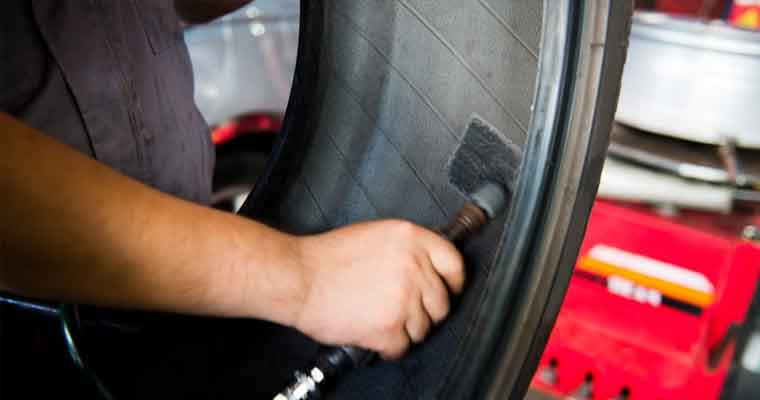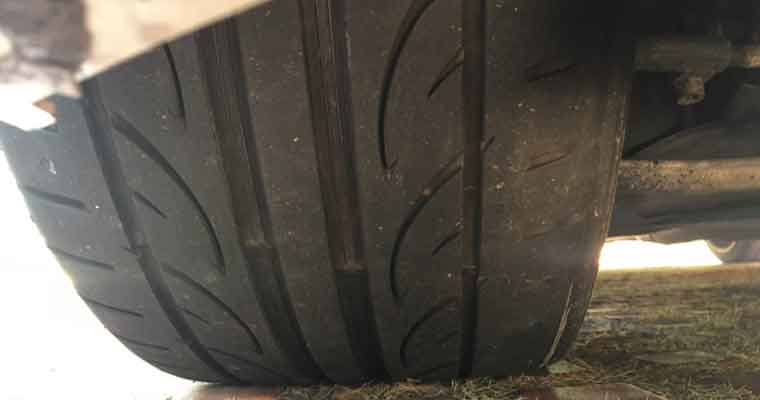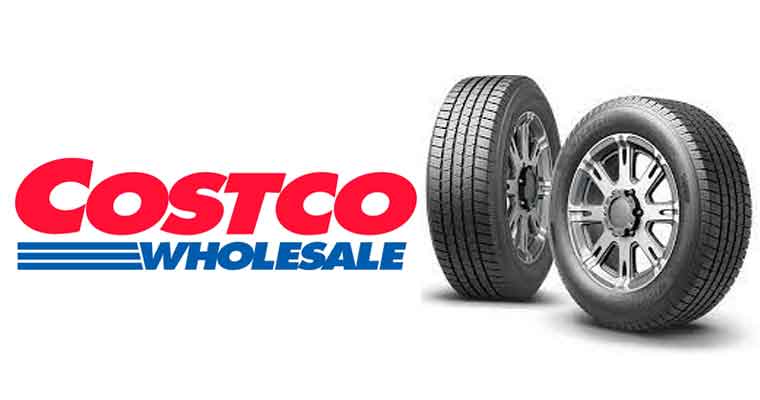Sidewall damage refers to any pertinent flaws or defects in the sidewall of your tires, whether on the inner or exterior side of the wall. It can entirely result in tire failure, which is a critical issue. Therefore, booking an appointment at a store such as Costco for getting new tires is the best way to deal with this problem.
Sidewall tire damage can range from tiny cuts and abrasions, bulging or bubbles, to more serious cases where significant chunks of rubber are gone since it refers to any anomalies detected within the walls of the tires.
You will find more details about these damages below. You will also get to learn about how to drive with sidewall damage and the precautionary steps that you should take in this situation.
1. Bubble on the Side of the Tire
A sidewall bubble is a projecting bulge on the side of the tire brought on by high-impact damage, such as running into a curb, hitting a pothole, or speeding over speed bumps.
You shouldn’t neglect it. This is just like you shouldn’t ignore any other sidewall tire damage because it could result in a blowout.
2. Chipped-off Rubber Chunks
These chunks of the tire’s sidewall have come away from the tire. The inner cables holding the tire’s structure together are presumably already visible.
3. Prominent Abrasions
Depending on how hard you strike something, such as a curb or a deep pothole, the size of your abrasions will differ. These can have a rough surface or, to some extent, a slash-like look. You must not ignore these abrasions regardless of their sizes.
Reasons For Sidewall Tire Damage
Tire sidewall damage is brought on by a variety of factors and You can read about these below. Then figure out the right way to fix such damage.
1. Deflated Tire
The driver’s carelessness is to be accountable for this. Tires are known to self-deflate at a constant rate naturally.
Thus, we should preserve the pressure at appropriate levels by regularly checking the tire. We are compelled to consider it negligent when this function is deliberately ignored.
2. Aged Tires
The optimal period for determining when tires are safe is between 8 and 10. After this period, the tire’s strength, flexibility, and everything else diminish, if not completely lost. Sidewall damage to tires is very likely to happen at this point.
3. Overloaded Vehicle
You are taking a chance at possible tire sidewall damage when you carry a weight that exceeds the vehicle’s permitted capacity.
According to the theory, a heavy vehicle could veer off the road and wobble from side to side, which could be highly dangerous. Damage to the tire sidewalls could be on the line when the vehicle sways on the road.
4. Worn Out Tires
Overheating occurs more quickly on worn tires than on new ones. If you hit a curb while your tires are in this state, tire sidewall damage may not be preventable as their cords may start to pull apart and become visible.
5. Low Quality Tired From Factory
Sidewall damage is more likely if a tire’s manufacturers wrongly rate it for speeds higher than it can handle.
Before tires are made available for consumption by the general public, it is crucial to do thorough testing to confirm their suitable speed rating for your vehicle. After installation, such low-rated tires are prone to overheating.
Repairing a Tire With Sidewall Damage
It would help if you did not try to fix sidewall damage as these are irreparable, whether it is merely a shallow scrape, a bulging, or a chipped-off portion of the sidewall. Even if you get a puncture, there is a limit on how close to the sidewall a tire can be patched or plugged.
Moreover, never consider taking the damaged tires to a tire technician because it is an unwritten industry policy not to patch, repair, or plug any damage which happened on the inside of the tire sidewall.
Repairing a damaged sidewall of the tire is impossible since any sidewall patch would fall off. This issue is due to the absence of cords on the tire’s sidewall, which makes it hard for the patch to stay in a hole. Tires have cords everywhere around their treads that keep patches in place.
A tire’s integrity is jeopardized once it sustains a sidewall injury, even with a patch. As a result, it cannot operate at peak efficiency and is no longer safe for driving. A blowout is very likely, even when operated at low speeds. If there is tire sidewall damage, replacing the tire right away is your best option.
Ways To Avoid Sidewall Tire Damage
By adhering to the fundamental guidelines, you can lessen the possibility that your tire’s sidewall will sustain damage.
These include routine tire maintenance, such as checking the air pressure at least once a month, avoiding potential road hazards, sticking to the recommended load and speed limits. Have your tires checked if you notice an issue. Learn more from the following cautions:
1. Maintain Tire Air Pressure
At least once a month, or whenever there are any obvious signs that the tires are underinflated, having them checked is necessary. The air pressure in tires changes as the temperature changes, so you should also take a cold tire pressure check.
It’s a good idea to keep a portable inflator charged by the power socket in your car nearby, along with a tire pressure tester. Since they don’t take up much room, you may store them with your standard repair tool.
2. Get Tires Checked Regularly
Throughout their knowledge, tire technicians and experts have dealt with various difficulties. Also, they might examine your tires for additional issues you might have missed when inspecting them.
3. Follow Speed Rating Recommendation
You must be able to interpret tire information, at the very least, in its basics. The imprinted code on the tire specifies the size and the recommended speed rating. Moreover, the load limit and the advised tire air pressure in psi are shown clearly on the tire information sticker on the door frame.
4. Drive Carefully and Avoid Hazards
Plan your trip in advance if at all possible. Avoid regions where there is active road rehabilitation or repair. There is a lot of construction debris, including sharp stones, nails, and other pointed metals. These could damage your tires’ sidewalls.
Additionally, keep an eye out for potholes in the road and exercise caution when driving close to curbs to avoid scratching the sidewall of your tire.
What More Should You Know?
Driving With a Sidewall Tire Damage
Driving on a tire with sidewall damage is never safe because, while you drive, the puncture, hole, or damage to the tire’s sidewall grows larger and worse, posing a risk to you and other road users owing to potential unexpected tire blowouts.
The control of the vehicle is disrupted as a driver manoeuvres on a tire with sidewall damage. This increases the likelihood that the automobile would veer off the road and cause an avoidable accident.
The sidewall of a tire is thought to be the weakest component, and its importance in maintaining driving safety should not be taken for granted. This concern is because, unlike all other components, it lacks cords that keep the rubber together.
Method To Read a Tire Sidewall
The sidewall of a tire is covered in numbers and characters that may not appear to represent anything. But these numbers and letters reveal a lot about the tire, including crucial specifications and other information.
You can make smart decisions when purchasing tires if you know how to read and understand the information on the tire sidewall.
What Do The Numbers Tell You On Your Tire?
Let’s take a look at a tire, for instance, which says “P225/50/R27 98H.” The P in the lettering, which designates your tire as a passenger tire, stands for PMetric. The tire is designated as a Light Truck Type when the inscription begins with LT rather than P, meaning that bigger vehicles cannot use it.
The tire section width, or the difference in millimeters between the two sidewalls, is indicated by the digit “225”. Depending on the rim’s size, this measurement will vary.
The tire’s section height and width are compared by the number “50,” representing a 50/50 comparison. According to this interpretation, the tire’s section height, in this instance, is equal to 50% of its section width.
The letter “R” stands for Radial Construction, the construction method used in its casing. Some tires may feature the letters “B” or “D” in place of the letter “R.” The letter “B” represents “belted bias construction,” whereas the letter “D” stands for “diagonal bias construction.” The final digit, “17,” represents the wheel rim’s diameter, often expressed in inches.
You can find the tire’s load index, speed rating, or service description by looking at the final few numbers.
We are confident that now that you have read this explanation, you realize that the numbers on the sidewall represent extremely specific information about the tire, not just a collection of arbitrary, verbose numbers.
Wrap Up
Any cut and other damage to the tire’s sidewall is referred to as sidewall damage. Driving on tires that have sidewall damage is not advised. The sidewall is an essential component of the tire’s structure. The damage may impact how the car handles or even result in a tire rupture. This may cause an accident.
Although there are numerous potential causes of tire sidewall damage, hitting a sharp curb or pothole is the most frequent. We recommend having a tire changed as soon as possible by a skilled mechanic. Tire sidewall damage is not worth skimping on; don’t try to cut costs.
We hope that you found this information useful! We are looking forward to reading your comments where you are encouraged to share any experiences you might have had with sidewall damages. Also, don’t forget to tell us how you got over the issues!







